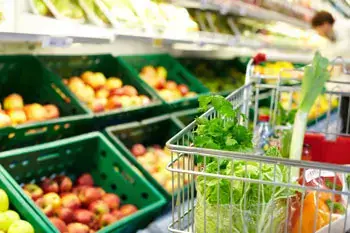Heart Healthy Grocery Shopping

According to the Centers for Disease Control and Prevention (CDC) heart disease accounts for 1 in 4 deaths each year and continues to be the leading cause of death among women and men. Heart-smart grocery shopping and the types of foods you purchase to consume may reduce your risk of heart disease or stroke by 80 percent.
Here are some tips to insure your trip to the grocery store will assist you in choosing heart healthy foods in an efficient manner.
- If you go to the grocery store hungry, you are much more likely to buy more than what you need as well as pick up impulse items. Have a meal or snack before you shop such as a sandwich and a piece of fruit or a non-fat Greek yogurt.
- By planning your meals/menus for the week and making a grocery list, you are much more likely to buy the healthy foods on your list. When we have a grocery list, we tend to have less impulse buys and can save a lot of money on our grocery bills.
- Check your pantry, cupboards, refrigerator, and freezer while preparing your grocery list to avoid duplicating purchases. Learn the store’s layout and write your list accordingly. Your grocery list can also be divided into categories such as produce, nonfat dairy, lean proteins, whole grains, etc.
- The more expensive food items are placed at eye level on the grocery shelves. Look high and low on the store shelves for the less expensive yet still nutritious similar product.
- Become a better Nutrition Facts food label reader. To incorporate heart healthy foods in your dietary pattern by lowering saturated fats, eliminating trans- fatty acids, and increasing fiber review this: http://www.fda.gov/Food/IngredientsPackagingLabeling/LabelingNutrition/ucm274593.htm
- Healthier foods are located around the edges of the grocery store. The interior aisles in most stores are loaded with highly processed foods. Obtain a grocery aisle map from the store and avoid aisles that do not have the foods on your grocery list. Navigate the perimeter of the grocery store to purchase heart healthy whole foods such as fruits, vegetables, whole grains, lean proteins and non-fat dairy products. Only visit the center aisles which contain foods such as brown rice, whole wheat pasta, oatmeal, quinoa, and dried beans.
Here is a handy guide to selecting the healthiest options at the grocery store:
PRODUCE (Fruits and Vegetables)
Purchase fresh produce that is in season for the best flavor and buy. In general, the darker the color, the higher the produce will be in nutrients. Frozen or canned forms processed without added sugar, fats, or sauces are a good choice. Dried fruits are a healthy, high fiber snack but are high in calories since the water has been removed so watch your portion size. Aim for five cups of produce each day to include cholesterol lowering fiber in your diet.
DAIRY
Buy only 1% or fat-free (skim) milk, buttermilk, cheeses, yogurts or, cottage cheese. Non-fat Greek yogurt is higher in protein than skim milk yogurt. Unsweetened or flavored “milks’ that have been fortified with calcium include soy, oat, or hemp milk.
LEAN PROTEINS
Plant based proteins such as tofu, miso, tempeh, lentils, dried peas, beans (dried or reduced sodium canned), edamame, hummus with no added oils, or textured vegetable protein foods(soy crumbles) are heart healthy since they do not contain saturated or trans fats.
Skinless white meat chicken and turkey, both whole and ground, are great choices if you are a meat eater. Just be sure that the skin was not ground in with the breasts. Seafood should be fresh or frozen without added breading or frying. Crustaceans (crab, shrimp, & lobster) are high in cholesterol and should be limited. Two servings per week of fish with a high content of omega 3 fatty acids is recommended. Good sources are wild salmon, tuna, mackerel, and sardines. Purchase canned albacore tuna, salmon, or sardines packed in water. Deli meats should be low fat and low sodium such as fresh turkey or chicken breast. Egg whites or egg substitutes are great choices. Nut butters should be freshly ground such as peanut butter.
If you eat red meats, limit your serving size to the size of a deck of cards and eat red meat no more than twice a week. Leaner cuts of beef and pork are loin, leg, round, & 95% lean hamburger. Venison, wild game, and bison are low in fat. Lean lamb cuts include roasts, chops, and legs.
BREADS, CEREALS, GRAINS, RICE, and PASTA
When buying breads or cereals make sure the first grain on the ingredient list is whole grain, such as whole wheat, oats, or millet. Baked goods should have 3 grams or less of fat per serving and cereals at least 3 grams of fiber per serving. Select brown rice, whole wheat or other whole grain pastas, whole wheat cous cous, quinoa, farro, flour, whole wheat tortillas, graham crackers and whole grain/ low-fat crackers and pretzels.
FATS and OILS
A teaspoon of fat has 9 grams of fat and 45 calories so use sparingly. Unsaturated oils include canola, olive, and peanut. Choose soft or liquid margarines and vegetable oil spreads that contain no hydrogenated oils. Light or nonfat salad dressings, seeds, and unsalted dry roasted nuts are better selections. Making your own salad dressing with flavored vinegars and a little olive oil will reduce the sodium.
The ability to control your heart health, weight, and overall health comes down to the foods you feed your body. So rethink your grocery list, shopping strategies, and food choices for you and your family’s heart health.
Always consult with your physician or healthcare provider before making any dietary/nutrition changes or commencing or changing your physical activity.
If you have questions or need more information about living a heart healthy lifestyle, contact Carrie Snyder, MSN, APRN, FNP-BC—Beebe Healthcare’s cardiac nurse navigator—by calling (844) 316-3334 or emailing [email protected].



